The Most Dangerous Place and Time in the Cretaceous
A Comprehensive Guide to the Fossils from the Kem Kem Beds of Eastern Morocco
A team of international researchers have documented the fossil vertebrates associated with the early Late Cretaceous (Cenomanian-Turonian) of the famous Kem Kem beds of eastern Morocco. They conclude that with the abundance of hypercarnivores such as Spinosaurus, abelisaurids, Carcharodontosaurus and Deltadromeus, several large pterosaurs and a multitude of giant fish and crocodyliforms, no comparable modern terrestrial ecosystem exists with a similar bias toward large-bodied carnivores.
Arguably, the sediments that make up the Kem Kem Group, which is composed of the lower Gara Sbaa and upper Douira formations, represent the most dangerous place and time in the whole of the Cretaceous.
Examples of Theropod Teeth Associated with the Kem Kem Group of Eastern Morocco
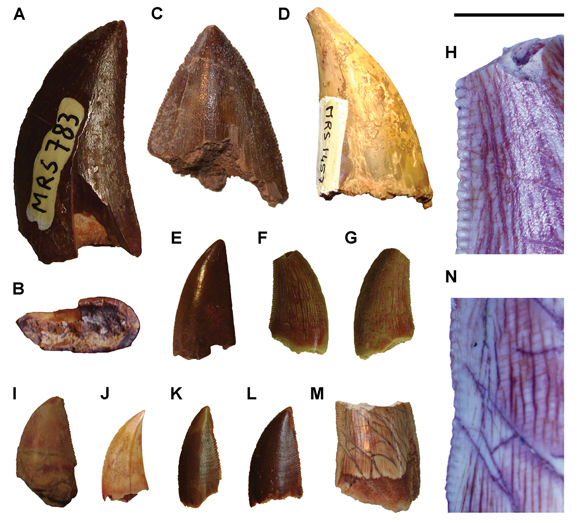
Picture credit: Ibrahim et al (ZooKeys)
An Ambitious Target
The researchers which included Nizar Ibrahim and Paul Sereno (University of Chicago), David Unwin (University of Leicester), Samir Zouhri (Université Hassan II, Casablanca, Morocco) and David Martill (University of Portsmouth), had an ambitious objective. The scientists set out to document and summarise the taxonomic status of the fauna that had been described based on the major collections of Kem Kem fossils, as well as to report on the geological age of the various strata and to plot the palaeoenvironment of this part of north Africa during the early stages of the Late Cretaceous.
The team’s comprehensive report has been published with free access in the journal ZooKeys.
The Changing Palaeoenvironment Represented by the Kem Kem Group Sediments
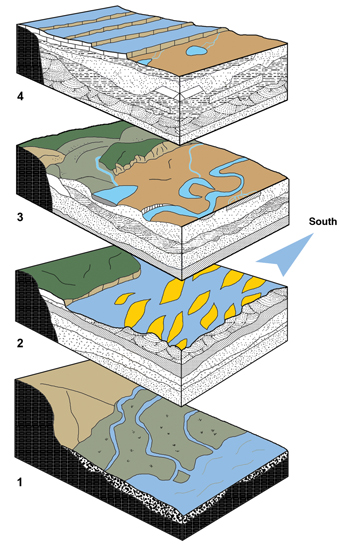
Picture credit: Ibrahim et al (ZooKeys)
A Very Dangerous Place to Be (Large Crocodyliforms and Pterosaurs)
The strata have provided evidence of large number of crocodyliforms from one-metre-long insectivores, herbivorous forms to giant predators such as Sarcosuchus imperator. Several different types of pterosaur are also associated with these deposits. The first pterosaur remains recovered consisted of isolated teeth collected in the late 1940s and early 1950s but at the time their affinity with the Pterosauria was not recognised. For an article from Everything Dinosaur about recent pterosaur discoveries from Morocco: Pterosaurs, Pterosaurs and Even More Pterosaurs.
Cervical Vertebra (Bone from the Neck) Ascribed to an Azhdarchid Pterosaur
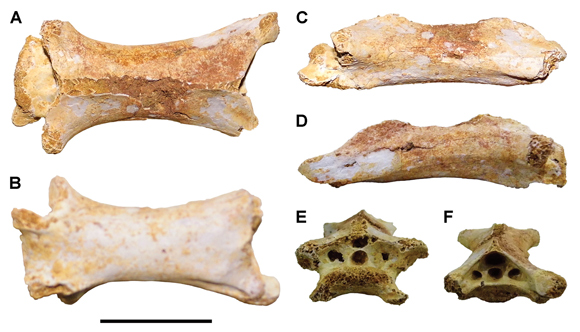
Picture credit: Ibrahim et al (ZooKeys)
In addition, the first tapejarid pterosaur from Africa was reported recently (Afrotapejara zouhrii), the trivial name honours Professor Samir Zouhri, one of the authors of the extensive review. To read an article about Afrotapejara: The Fourth New Moroccan Pterosaur – Afrotapejara.
Lots and Lots of Dinosaurs – A Bias Towards the Theropoda
Dinosaurs are strongly associated with these strata, but there is only very fragmentary evidence of ornithischians including a single, large footprint. This suggests that bird-hipped dinosaurs were present but, in contrast to most other Cretaceous biotas, they seem very much underrepresented by the fossil material. Sauropods such as the rebbachisaurid Rebbachisaurus garasbae and titanosaurs are known from both the Douira and Gara Sbaa formations, however, it is theropod specimens that dominate the Dinosauria associated with the Kem Kem Group. There is evidence to support one medium-sized to large Kem Kem abelisaurid and the discovery of single neck bone (cervical vertebra) indicates a Noasauridae presence.
Huge hypercarnivores such as Carcharodontosaurus saharicus and Spinosaurus aegyptiacus have been reported. The habitat seemed to have an overabundance of large, carnivorous dinosaurs, although extensive niche partitioning is proposed by several authors.
Perhaps the Most Famous African Dinosaur of them all – Spinosaurus aegyptiacus
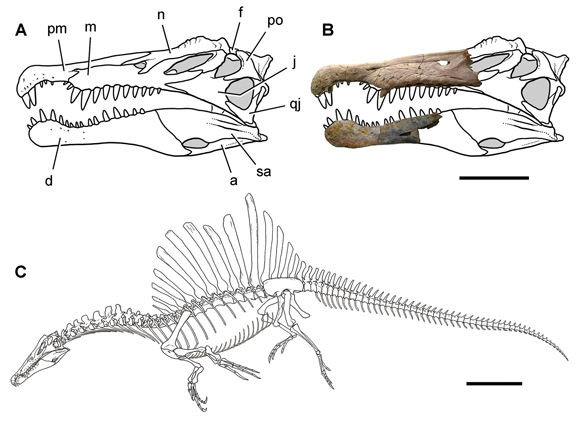
Picture credit: Ibrahim et al (ZooKeys)
Deltadromeus agilis
One of the most mysterious of all the theropods from Morocco is Deltadromeus agilis. The taxonomic position of this meat-eater remains controversial. A partial skeleton (UCRC PV11), was discovered in a coarse sandstone layer in the upper portions of the Gara Sbaa Formation. The bones were found in association with teeth of the huge sawfish Onchopristis as well as teeth from crocodyliforms. Fossils associated with D. agilis from eastern Morocco show a resemblance to isolated material recovered from the roughly contemporaneous Bahariya oasis in the Western Desert of Egypt by the German palaeontologist Ernst Stromer.
The Egyptian fossils were assigned to the taxon Bahariasaurus ingens, but the Moroccan and Egyptian material could represent the same genus. If this is the case, then D. agilis would become a senior synonym of B. ingens. A single thigh bone from the Bahariya oasis measures 144 cm long. This suggests that whatever sort of carnivore Deltadromeus/Bahariasaurus was, it was huge. Some commentators have suggested that based on femur proportions Deltadromeus could have been only slightly shorter (but more lightly built), than Tyrannosaurus rex.
Holotype of D. agilis (A) and Compared in Size to the Egyptian Femur Specimen (B)
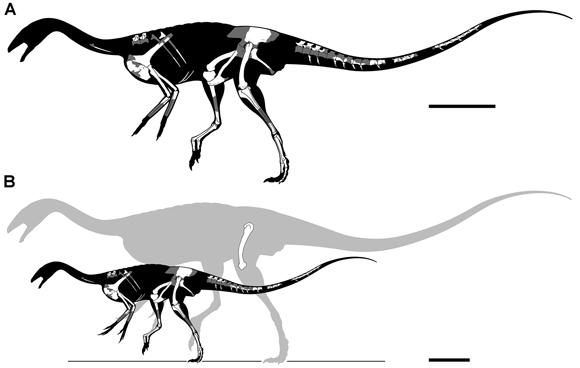
Picture credit: Ibrahim et al (ZooKeys)
Sadly, like much of Stromer’s material from the Egyptian expeditions, the femur has been lost.
It is very likely that there were lots of smaller predatory dinosaurs too. Dromaeosaurid teeth have been reported from several localities but bones are exceptionally rare and the only positively identified dromaeosaurid skeletal elements are some foot bones found in Sudan and recovered from Cenomanian-age rocks.
A Predominance of Aquatic Predators
The authors state that the Kem Kem assemblage is dominated by aquatic and subaquatic invertebrates and vertebrates, the majority of which are predators. They suggest that as most of the taxa are exploiting aquatic food resources, then like modern marine food chains, the habitat is predator dominated. As to the overabundance of carnivorous dinosaurs compared to plant-eating ones, the researchers conclude that this is not due to sampling bias or preservation factors. Large theropods in the food web were supported primarily in the case of Spinosaurus or secondarily in the case of the terrestrial carnivores by the huge amount of aquatic protein sources.
For models of Carcharodontosaurus, Spinosaurus and other theropod dinosaurs: PNSO Age of Dinosaurs Models and Figures.
The dissected deltaic plain and nearshore environments may have enhanced aquatic resources while limiting, or rendering patchy areas of available vegetation for large-bodied dinosaurian herbivores. Hence the bias towards carnivores when it comes to assessing the fossilised remains of dinosaurs from the Kem Kem beds.
The Presence of So Many Carnivores could be Explained by the Abundance of Aquatic Food Sources such as Small Fish
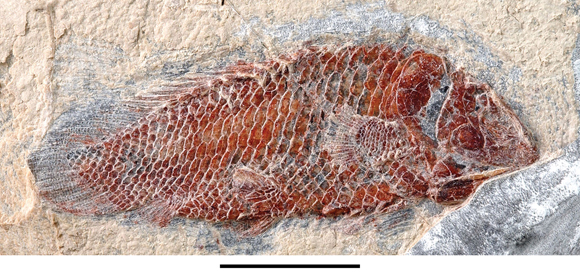
Picture credit: Ibrahim et al (ZooKeys)
The scientific paper: “Geology and paleontology of the Upper Cretaceous Kem Kem Group of eastern Morocco” by Nizar Ibrahim, Paul C. Sereno, David J. Varricchio, David M. Martill, Didier B. Dutheil, David M. Unwin, Lahssen Baidder, Hans C. E. Larsson, Samir Zouhri and Abdelhadi Kaoukaya published in ZooKeys.
Visit the Everything Dinosaur website: Everything Dinosaur.

